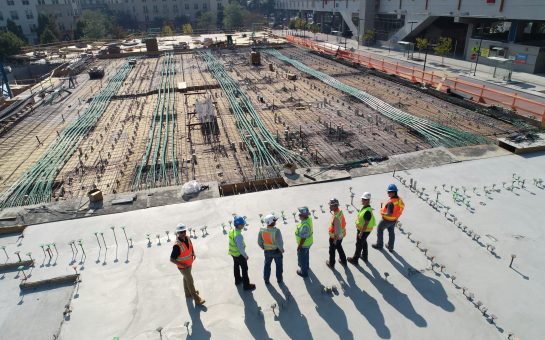By SWL staff
April 29 2020, 20.25
Follow @SW_Londoner
You’ve started your company, you’ve grown, and now you need to hire more than a handful of employees; but what do you do first?
Something that all new growing businesses will go through at some point and something that many don’t spend too much time thinking about is acquiring office space and deciding on a layout for the office.
There is a vast array of ways to design an office layout, and there are all kinds of things to consider when you do, particularly if you have a varied workforce who are all doing different things.
How do you design an office that uses less space for your external sales consultants who are only in the office for an hour a day or for a remote workforce that also need to have office space from time to time? Do you use an open plan office floor or give everyone an office? What about your reception area?
The layout of your office is going to have a direct impact on your employee productivity and morale, so let’s examine some of these questions and see if we can shine a light on the complexities of business office space design.
The Traditional Office
This is the layout of an office you’re going to think of when you first think of a company’s offices. A reception area leads to a passage with individual offices for your employees. These might be interspersed with meeting rooms, a kitchen or two which might double as a cafeteria, and a boardroom. You might also provide a lounge for employees to take breaks.
You might be forced into this kind of office space layout if you’re a company that needs the privacy to consult one-on-one with employees or your clients. Law firms or medical practices are good examples of where the traditional office is necessary. It’s not all a bad thing though. Your employees can design their spaces and add personality to them, which might improve their morale. Their workspaces will also be quiet making focusing on their work easier.
The traditional office does have some distinct disadvantages too, however.
- Isolation – because your employees are going to spend most of their working day isolated from each, collaboration might suffer.
- Additional space for collaboration. You need to spend some real-time thinking about including spaces which directly improve collaboration such as:
- Meeting rooms
- A cafeteria
- Employee lounges
- Collaboration spaces
The traditional office is probably still the most popular way of designing office space today, and it certainly has its advantages, but that doesn’t mean you shouldn’t consider some of the newer and more innovative ways of laying out your office.
The Open Space
We find this type of office space more often than not in companies with younger leadership and employees. It’s a popular choice in agencies and tech start-ups where space might be at a premium or where collaboration is strongly encouraged. These companies will likely have flat hierarchies where the need for private offices isn’t a high priority.
The open office has district advantages in its design:
- Communication – Because of the ease of communication between employees, you’ll have decisions being made quicker and an increase in agility of your workflows.
- Productivity – Ultimately, you’ll probably see an increase in the productivity of your employees – if they’re the right kind of people for this layout.
- Cheaper – It’s also much cheaper to build because you’re not putting up lots of drywall and constructing partitions.
- Saving on Fixtures – You can also save on lighting fixtures and other room-by-room necessities like air conditioning ducting and similar.
If you’re going to go for the open space office design, don’t forget to include a reasonable amount of space dedicated to privacy. This means pods employees can use if they need privacy to take a phone call or meet with a manager. Your employees also might need a quiet place to spend some time on a project, as open space designs can be noisy.
The Cubicle or Partition Style Office
Sitting in the middle of the traditional office and the open space office and creating a happy hybrid is the cubicle style office. The ever-increasing popularity of the cubicle or partition style office is for good reason. It offers a degree of privacy while still promoting collaboration and flexibility. It also maximises the office floor space in businesses where a degree of privacy is needed, but it’s perhaps not necessary to have complete confidentiality. This is the middle-ground design between privacy and collaboration.
You’ll find the cubicle or partition style office in bigger organisations that have many employees in a smaller space.
Some examples of companies that might use cubicles include:
- Telemarketing companies
- IT helpdesks
- Call centres
- Banks
- Consultants like insurance companies
Specific companies will favour this design, and usually it will be for privacy reasons. These are companies like banks and other consultative businesses where a cubicle can be used to offer some privacy while still making good use of the space.
The partitions or cubicle walls offer some protection from sound so if your employees spend a lot of their day on the phone or talking to clients, there are real advantages to using cubicles over open space or team collaboration clusters.
There are many ways to design this office, so if you do opt for a cubicle office design, you’ll need to spend some time thinking through the options. The most important consideration here is to not try and fit too many cubicles into too small a space. Make sure you leave enough room for walkways between the cubicles and to avoid your employees feeling claustrophobic.
Team Clusters
Leaning more towards the open office environment is the team cluster. Usually, you’ll find these kinds of office layouts in companies where different teams are performing very different roles or jobs. It’s the design of ad agencies or bigger more progressive corporate environments.
It’s another hybrid that offers great communication between members of a team performing the same role or function, but privacy between departments and a less distracting environment than a fully open office environment.
This is another area where you’ll want to include a good number of meeting rooms and private pods for your employees to escape to for some quiet should they need it. You’ll also need areas where teams who are collaborating on projects can work and discuss together.
You’ll Probably Need a Combination
Naturally, you almost certainly can’t just choose an office style and implement it across the board, because your employees aren’t all going to fit one mould. Combining some of these office layouts is likely going to be what fits your needs.
- Manager and Team – You might want to have a private office leading out into an open space, so the manager of the department has an office for one on one consultations with their staff, but the staff also have the collaborative advantages of the open space.
- Senior Management – You might also include an area of your office space that has a more traditional layout for your management team who need their own offices due to the confidential nature of their work and interactions with other staff.
- Complete Hybrid – You might only need one department that makes use of a cubicle style office layout, like a call centre, while the rest need traditional offices.
Many of the reasons for choosing a specific kind of workspace will be something you’ll learn in a practical course like a DBA. Click here to find out more about the differences between a DBA and a PhD.
Do You Consider Co-Working Spaces?
The co-working space is the new kid on the block of office design. More and more companies are embracing work at home or remote work policies which allow their employees to be out of the office for a few days a week. You might also have a workforce of salespeople or employees that are on the road or travelling often, and dedicating office or desk space to them might be superfluous. This is where the co-working space comes in.
In a co-working environment, employees might not be assigned a working space, but instead the company will provide workspaces in the form of desks, pods, couches or other working spaces that employees will just use when they’re needed on a first come first serve basis. It means that you’re not renting unnecessary office space or dedicating space to employees that might only spend a couple of days a week in the office but making full use of the office space you actually need.
It does mean that employees might start to feel like they don’t have a ‘home’ in the office so it’s worth considering the kind of employee you have before using the co-working space. It also has all the advantages of increasing collaboration if you have a highly agile company structure, where collaboration between teams might constantly shift.
Office layout and design is not an exact science and almost always you’re going to need to combine at least a few of the different design options to get the most out of your employees and space. By avoiding the common design mistakes with each type of office type and using the designs to better suit each team’s needs and way of working, your office will become one of your biggest assets for keeping your employees happy and productive.




